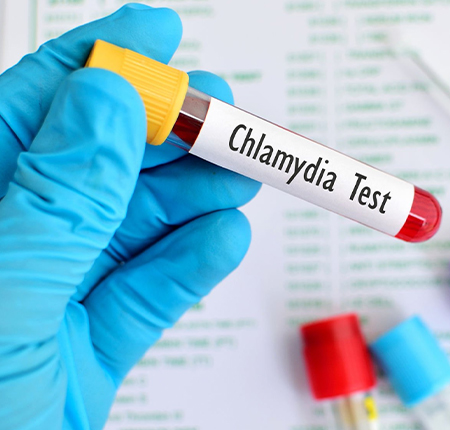
Although it occurs predominantly in young women, Chlamydia can affect both women and men of all ages, and can be transmitted to anyone through sexual contact. The problem is that although it is easily treated, it can go undetected due to the lack of symptoms – and without treatment, it can cause more serious health problems.
So today we prepare you with everything you need to know about how it is transmitted, what it is, how to treat and how to prevent Chlamydia, one of the most common sexually transmitted infections.
What is Chlamydia?
Chlamydia is a sexually transmitted infection caused by a bacterium called "Chlamydia trachomatis". It often goes unnoticed because the symptoms do not exist, or appear only very late.
In women, Chlamydia first infects the cervix (which can lead to signs of cervicitis), then it can spread to the rest of the reproductive system, including the uterus and fallopian tubes . It may also affect:
- The urethra , causing symptoms such as the need to urinate frequently or pain/burning when urinating
- Rectal , either directly through unprotected anal sex, or indirectly, spreading from the cervix and vagina
- Throat , directly through unprotected oral sex, although it usually does not cause symptoms or cause pharyngeal problems
- Eyes , because contact with infected genital secretions often causes conjunctivitis (an inflammation of the eyes manifested by redness and itching).
Who are prone to be affected by Chlamydia infection?
Chlamydia is the most common sexually transmitted bacterial infection, and not only in Romania. To give you an idea of how common it is, check out some statistics below:
- In 2018, the number of people infected in the United States was estimated at 4 million.
- 1 in 20 sexually active young people (aged 14-24) are affected, and two thirds of new infections occur in 15-24 year olds.
- In 2020, approximately 128.5 million new infections among people aged 15 to 40 years were recorded worldwide.
- In Europe, Chlamydia is the most common sexually transmitted infection. It is so easily transmitted because most infected people don't know they have the bacteria (because they don't show any symptoms) and therefore don't get tested and pass it on.
- In Romania, according to the Romanian Anti-AIDS Association, most cases of Chlamydia trachomatis infections are diagnosed at the European level, especially in women between the ages of 20-24.
Already from the statistics above you can figure out who are the people prone to this infection. But in order to have the clearest possible picture, look below which are the most vulnerable groups:
- Sexually active people, especially young people, who have unprotected vaginal, anal or oral sex (without a condom or other barrier method)
- People who have intimate contact with an infected partner
- Those who have sexual contact with several partners
- Women are more prone to Chlamydia infection than men.
Without testing, people do not know they have Chlamydia and thus do not receive treatment, contributing to the spread of the infection. But in addition to this, another factor that contributes to the status of "the most common bacterial sexual infection" is the fact that it can be transmitted in many ways. Next we tell you what they are.

The ways in which Chlamydia infection can be transmitted and spread
Although Chlamydia infection can be contacted in several ways, the main way of transmitting the bacterium is sexually, that is, through unprotected sexual contact. Let's talk about how, exactly, the infection can spread :
Unprotected sex
It is the most widespread method of transmission, and refers to all forms of unprotected sexual contact (oral, vaginal or anal). Ejaculation does not in any way influence the extent to which infection occurs, as the bacteria can be transmitted even in the absence of semen.
Vertical transmission
During childbirth, the mother infected with this bacteria can transmit the infection to the fetus. Microorganisms are transferred vertically, through the vaginal canal. Conjunctivitis and pneumonia can be two of the symptoms of the newborn infected with the bacteria Chlamydia trichomoniasis.
Using sex toys
Even toys can be carriers and transmitters of the bacterium. Although less common, it can happen that using a sex toy after it has been used by or with an infected person can lead to a new Chlamydia infection.
It is best to use only your own toys. Or, if you're not the only user, just use them with a condom (and a water-based lube that won't damage it) and clean them before and after each intercourse.
Direct eye contact
Chlamydial conjunctivitis is an inflammation of the eye that gets there due to infection with Chlamydia trachomatis. This happens if genital secretions containing this bacteria reach the eyes, for example when you touch your eyes after touching your intimate area (if you suffer from Chlamydia) or that of an infected partner.
Risk factors
Once you know who is susceptible and how the bacteria is transmitted, it is easy to identify the main risk factors for Chlamydia:
- Age : young and sexually active people between the ages of 15 and 24 are more vulnerable to infection, according to statistics.
- Gender : There is research to suggest that women are more prone to infection than men.
- Number of sexual partners : the more sexual partners you have, the greater the risk of transmitting the bacteria because of the possibility that one of the partners is infected.
- History of sexually transmitted infections in the medical history : if you have had chlamydia in the past or other sexually transmitted diseases, there is a possibility of recurrence if you have unprotected sexual contact with an infected partner. If you want to read more about sexually transmitted infections and how to protect yourself, we have an article on the blog where we talk exclusively about sexually transmitted diseases .
- Sex without consent : it is possible for the mother to transmit the bacteria to the fetus at birth, in which case conjunctivitis, pneumonia, and genital or rectal infection that persists for up to a year can occur. Apart from this situation, if a girl over 1 year of age shows signs of vaginal, rectal or urethral infection, the risk of abuse can be considered.
What are the symptoms of Chlamydia infection?
Many infected people do not have any symptoms, which is why Chlamydia is also called a "silent infection". This is also the reason why it is so easily transmitted: people do not know they have it, they continue to have unprotected sex and do not follow any treatment.
When symptoms do occur, it can take up to three weeks to be noticed, and they differ for women and men as follows:
Symptoms found in women
The earliest symptoms are the mildest, increasing in intensity as the infection worsens. In women, the most common symptoms are:
- Abnormal vaginal discharge with a strong and persistent unpleasant odor (By the way, did you know that there are a lot of other reasons why the color, consistency or smell of your vaginal discharge can change? We talked more about this in a separate article and you can read HERE . I explained in detail what to pay attention to and what each type of secretion means.)
- Pain or burning sensation when urinating
- Discomfort in the lower abdomen
- Bleeding outside of menstruation or increasing its duration (we talked more about the topic of intermenstrual bleeding in THIS article, so you know when to worry).
If the infection is left untreated and worsens, other symptoms may occur:
- Abdominal pains
- Pain during intercourse (But Chlamydia is not the only cause of pain during or after intercourse, and if you have no other symptoms of the infection, there may be many other reasons why you feel pain. However, painful sex is never normal, so it's good to know exactly what the cause is and discuss this with your doctor. I told you more in another article about dyspareunia and the causes of pain during sex .)
- Bleeding after intercourse
- migraines
- Fever
And when the infection occurs at the anal level, symptoms can include:
- Pain
- LEAK
- Bleeding
Symptoms found in men
In men, the most common symptoms of Chlamydia infection are:
- Penile discharge
- Burning sensation or pain when urinating
- Pain, discomfort or inflammation of one or both testicles (but this is a less common symptom than the first two)
As in the case of women, if the infection occurs at the anal level, the symptoms are identical in men. Rectal pain, bleeding or discharge may occur.
When should you go to the doctor?
If you had unprotected sex and you find out that your partner was infected, go to the doctor as soon as possible for treatment. Likewise, if you notice vaginal or anal discharge, or if you experience pain or a burning sensation when urinating. Basically, if you notice any abnormal symptom or any change in the intimate area, it is best to visit the doctor.
Diagnosis of Chlamydia infection
Diagnosis is based on symptoms, medical history and laboratory tests. Both the specialist doctor (urologist, gynecologist, dermato-venerologist) and the family doctor can diagnose Chlamydia infection.
Diagnostic methods
In addition to the sexual history and assessment of risk factors, the doctor may perform clinical testing, including examination with a speculum and palpation, to make the correct diagnosis. Also, to confirm the presence of Chlamydia trachomatis bacteria, the following tests can be done:
- Laboratory tests based on collected samples: are standard molecular tests for the diagnosis of Chlamydia, which are made on the basis of a sample of secretion collected with the help of a cotton swab, and which accurately confirm the presence of the bacterium.
- Nucleic acid amplification tests: are considered the most accurate and effective tests, which can be done both on the basis of a sample of secretions (collected either by the doctor or by the patient) and urine (the method usually used for diagnosing men).
- Serological tests: based on blood samples collected by puncture.
Once Chlamydia is diagnosed, testing for other sexually transmitted diseases (including syphilis, gonorrhea, and HIV) is also recommended, as is sexual partner notification.

Antibiotic treatment
Chlamydia is a treatable and curable infection. Most often, the doctor prescribes an antibiotic, along with the recommendation of abstinence from sexual contact for at least 7 days after the end of treatment (or the correct use of a condom during this time).
Also, other recommendations during and after treatment include:
- Treatment of sexual partners: If infected partners are not treated, re-infection can occur.
- Maintaining proper intimate hygiene: with an antibacterial intimate gel that does not alter the vaginal pH and protects the skin's immunity, keeping the intimate area clean without causing irritation. Enroush intimate gel contains 95% natural ingredients, without sulfates or fragrances with allergens, being suitable even for sensitive skin.
- Repeat tests 3 months after the end of treatment: to confirm that the infection has not recurred.
Possible complications
If left untreated, Chlamydia can lead to several serious health problems, especially in women. In advanced stages, the infection is associated with other conditions, such as:
- In women : pelvic inflammatory disease, abdominal and pelvic pain, ectopic pregnancy and infertility.
- In pregnant women : premature birth.
- In newborns : conjunctivitis and pneumonia.
- In men : epididymitis (painful testicle infection), prostatitis and, very rarely, infertility.
- In both sexes : joint inflammation (reactive arthritis), conjunctivitis.
Frequently asked questions about Chlamydia infection
Can Chlamydia infection be prevented?
Since the main way of transmission is sexual, the only way to prevent Chlamydia infection is the correct use of barrier methods at every sexual contact (the foil for oral sex or the condom for any form of sex). Also, washing your hands properly every time after touching your intimate area or your partner's is a method of preventing the spread of bacteria to the eyes, thus preventing conjunctivitis.
Can Chlamydia be transmitted through kissing or other casual contact?
Chlamydia can only be transmitted through a form of intimate contact, namely through sex (vaginal, anal or oral), or from mother to fetus during birth. The only way it can spread through casual contact is through contact of infected genital secretions with the eyes.
How long does it take to cure Chlamydia infection?
Antibiotic treatment for Chlamydia can last between 7-14 days, with retesting every 2-3 weeks to confirm cure. Afterwards, a set of tests is recommended after 3 or 5-6 months, to know for sure if the infection has left the body.
Is sexual abstinence necessary during treatment for Chlamydia?
Yes, it is recommended to avoid unprotected sexual contact during treatment, as well as for 7-10 days after its completion. If abstinence is not possible, condoms must be used correctly every time.























